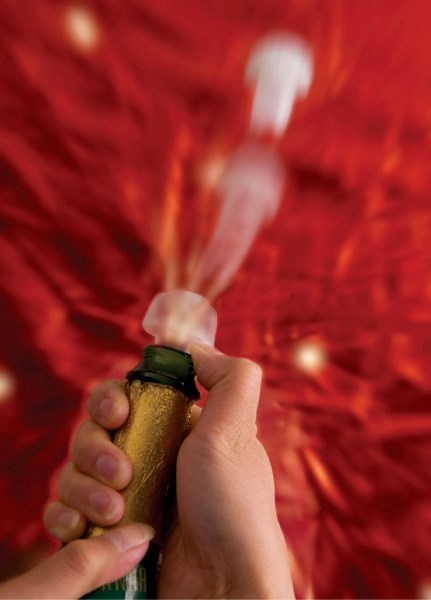If you choose to open your New Year's champagne with a sword, use extreme caution.
At least that's the recommendation of wine expert Rosanne Winter-Repchuk, who has tried the stunt herself — once — in her sommelier class at NAIT. And she did open the bottle. But sadly, she lost some precious champagne in the process.
"Supposedly, after a victory on the battlefield, Napoleon and his troops used their bayonets to open their champagne," said Winter-Repchuk, of Campbell Liquor Store.
It's worth noting that Napoleon et al were probably outside when they opened their wine in such a dramatic fashion. It's also not likely that they wore protective eyewear, but Winter-Repchuk points out that it's a good idea.
"Remember that this bottle is under a lot of pressure," she said, as she explained that, at least in this instance, ritual is important.
"You put the top of the champagne in ice until it is super-duper cold. Keep the cage over the cork on. Then you tip the champagne on its side, and you run your sword up the seam on the top of the bottle. You touch the bottle once, then twice and the third time you hit the neck of the bottle as if you mean it," she said.
While this method might impress guests, it may also lose something once you trot them all outside to witness the performance. Winter-Repchuk suggests using a more gentle method to open champagne, which involves slipping one thumb over the top while you carefully and slowly push the cork out with your other thumb.
"You don't want your cork hitting the ceiling, as happens in the movies. You lose too much champagne," she said.
Losing champagne would be a shame if you've popped the cork on a bottle that cost you a lot of money but a bottle of great-tasting bubbly needn't be that expensive.
The most luxurious champagnes, from Champagne, France, may cost $300 or more. But you can get a good value sparkling wine for $15, said Peter Seepish a sommelier for Liquid Harvest and Lacombe Park Spirits.
Sparkling confusion
Champagne is the conundrum of the culinary world because not all sparkling wines are champagne. To add to the confusion, some wines may be fermented in the traditional way and they may have great effervescence, but they may not legally be labelled champagne, because the vintners in that region of France have a monopoly on the name.
Traditionally, yeast and sugar is added to a bottle of wine to add carbon dioxide or effervescence. This method is used in many wineries all over the world, but it's said that the chalky soil of the Champagne region of France makes the best sparkling wine.
"When you taste true champagne there are nuances and flavours that you never get in sparkling wine because of the yeast they use. The champagne has a complexity of taste," said Seepish, who toured the vineyards of the Champagne region and walked down in the caves to see where the wine is chilled.
Winter-Repchuk said the difference in taste is extreme but both kinds of wine may be delicious.
"It's like the difference between lasagne made with tomatoes and meat sauce or lasagne made with chicken and cream. Both are good. It doesn't matter what it costs or where it came from but it does matter whether you enjoy it," she said.
The most expensive wines sold locally are Cristal, Dom Perignon and Armand de Brignac, which cost in excess of $300 per bottle.
But Pol Roger, which costs approximately $60 locally, was the sparkling wine chosen for the wedding table of the Duke of Duchess of Cambridge. The wine was one recommended by both sommeliers.
Cava sparkling wines from Spain range between $13 and $30 and are also popular choices this year. Brands to look for include Christilino and Segura Viudas Heredad. A popular Canadian wine is Sumac Ridge and from Italy, try Prosecco.


